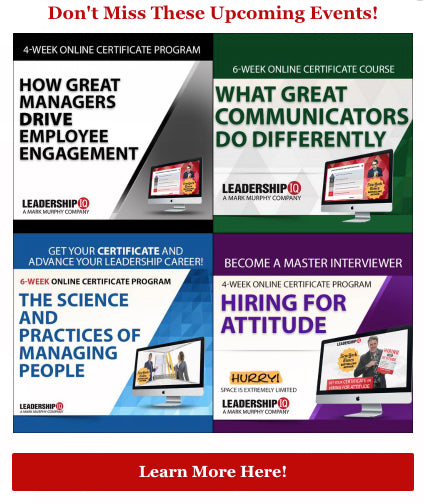If 2017 Didn't Deliver The Career Success You Wanted, Try Making This One Change
This article originally appeared on Forbes by Mark Murphy, Founder of Leadership IQ
According to a survey I conducted last week (of more than 5,000 leaders) only 22% of people say they’re very satisfied with their current position. The other 78% are divided between advancing a little or advancing far beyond their current position.
In essence, whether you want a little or a lot more from your career, odds are that you don’t want to remain exactly where you are.
So if this year didn’t bring the big jump you were hoping for, what should you do differently in 2018? Well, I’ve got some research that may have the answer.
More than 10,000 leaders and professionals have taken the online test “How Do You Personally Feel About Change?” One of the questions asks respondents to select from these options:
- I like taking risks.
- I would take a risk if it seemed prudent.
- I avoid risks.
Overall, about 28% of respondents say that they like taking risks. Clearly, not everyone is a risk taker, and that’s fine. But for people that are highly ambitious and want to advance a lot more in their career, taking risks are likely to be at least somewhat necessary.
And that became evident when I dissected the data by position. For instance, 40% of top executives like taking risks. But for frontline employees, that number is only 24%. So in the average company, the CEO is 66% more likely to enjoy taking risks than the employees.

Now, I’ll be the first to admit that correlation doesn’t always equal causation, but in this case, the differences are so stark that it’s evident that being a top executive and taking risks are at least moderately linked.
Of course, this doesn’t mean you should start taking risks just for the sake of being riskier. But I’d recommend considering something like the following.
Step 1: Think about this past year, looking for situations where you opted to take a safer course of action. Maybe it’s a meeting in which you kept quiet about your big idea. Or tough feedback you didn’t give a colleague. Or when you didn’t volunteer to present at the executive team meeting. Regardless of the specifics, most people can look back over 12 months and find at least a few times when they opted for a less risky option.
Step 2: Ask yourself why you didn’t go for the riskier path. Typically, what stops people from taking a risk seems at first to be a fear of failure. For example, I could say that I didn’t pitch my big idea at the meeting because I was afraid it would get rejected. But that fear of my idea getting rejected is really just masking a deeper fear; namely that ‘I’ll die from embarrassment’ or ‘I’m not as smart/talented/skilled as I think I am’ or ‘this is my only shot at this and if I screw up I’ll never get another chance.’
Some fear is very healthy; from an evolutionary perspective, fear kept us alive. If you fail to escape the sabretooth tiger chasing you, there’s a good chance you’ll die. But if you take a risk to pitch your idea in a meeting and it gets rejected, the embarrassment you feel probably won’t kill you. Most of the repercussions we face if we fail when we take a risk won’t really kill us; they’re interpretations, assumptions, emotionally charged extrapolations, catastrophizing, or irrational beliefs. Call them what you will, but the consequences of failing from having taken a risk at work are not typically life-and-death.
Step 3: Commit to taking a risk in 2018 that you would have avoided in 2017. And by ‘commit’ I mean literally write down on a piece of paper something like “I’m going to pitch my new product idea at the team meeting on January 15th.” And once you’ve written it down, put it on your desk where you can see it and then get to work preparing your pitch.
I’m not saying that taking risks is the only way to fulfill your career ambitions. But it is notable that top executives are significantly more likely than other roles to like taking risks. And how did they get to ‘like’ taking risks? Typically, liking risks comes from actually taking a bunch of risks and having a number of them pan out. So to get yourself started down that path, you’ve got to take a few more risks.
Remember, you likely had more than a few opportunities this year where a less risk-averse person would have ‘gone for it.’ So just find a few of those opportunities in 2018, and instead of taking the safer path, go ahead and go for it. It’s probably what the CEO of your company would do.
Mark Murphy is the founder of Leadership IQ and author of Truth At Work: The Science Of Delivering Tough Messages.









